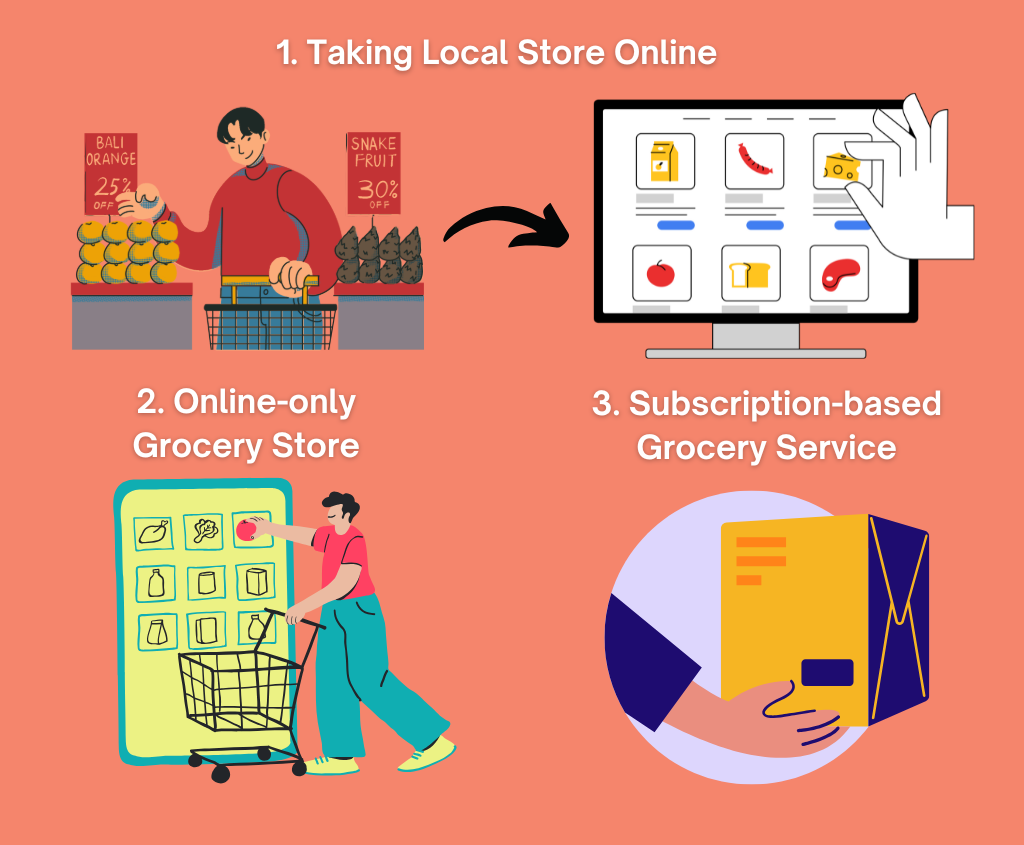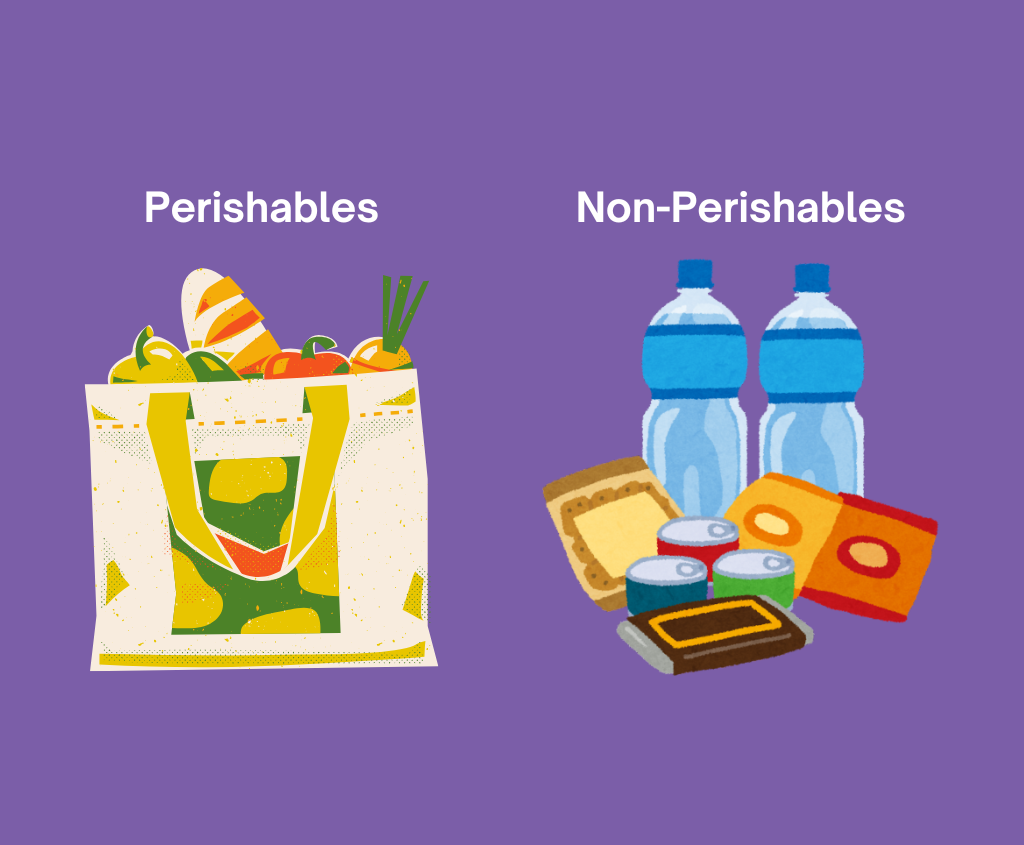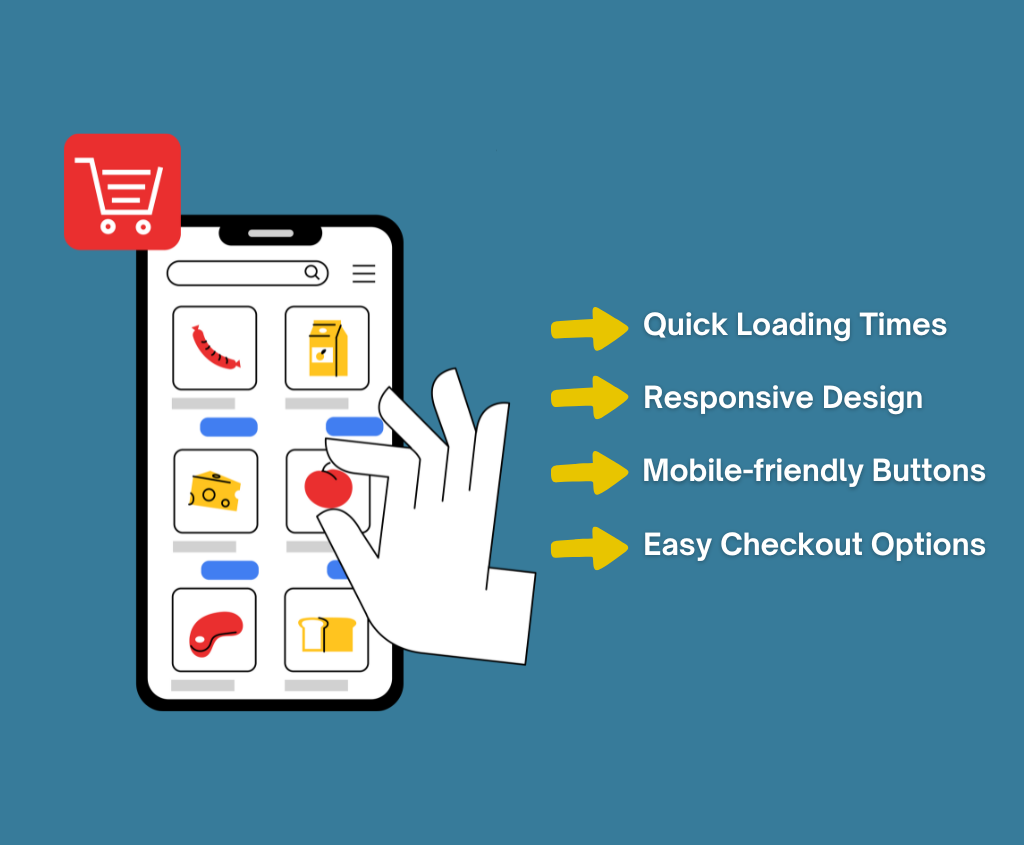Are you searching for a way to take your existing grocery store online, or do you want to build an online store from scratch? Either way, you’ve come to the right place!
Building a sustainable online grocery store isn’t easy, and while there are a lot of steps to complete before you start fulfilling orders, the results are well worth it.
In this blog, we will provide a step-by-step guide on how to start an online grocery store, which includes platform recommendations, tips on managing your inventory, delivery options, payment methods, and more.
So, stick around to learn more and grow your essentials store online!
How to Start an Online Grocery Store in 7 Steps
Learning how to start an online grocery store is a difficult process. Fortunately, the steps below will guide you through the entire process so you can get started on the right path.
Before we get into it, we highly recommend that you start by ensuring compliance with local and national regulations on food storage, transportation, and handling to avoid any unnecessary complications along the way.
Step 1: Choose Your Business Model
Start by choosing which business model you want to employ, as this choice will shape everything from how you manage your inventory to how you fulfill your orders.

Taking Local Stores Online
If you already own a local grocery store, expanding it online can be a natural next step. You can attract a larger audience by offering home delivery, curbside pickup, or both.
This model works well because you already have a supplier network and inventory in place, so you only have to adapt your operations to the online space.
Online-only Grocery Store
If you’re starting from scratch, you may opt for a store that only operates online. But to do this, you need to set up a warehouse and handle fulfillment by yourself or work with third-party logistics providers.
You can also use dropshipping to sell products without holding inventory. This way, suppliers will ship orders directly to customers to help reduce upfront costs. But the responsibility of quality control and reliable deliveries falls solely on you (the store owner).
Subscription-based Grocery Service
This model is a recently growing trend where you can offer curated products regularly. While subscription models create predictable revenue and build customer loyalty, you will need a strong relationship with your supplier and consistent product quality to keep customers coming back.
Some popular examples of this model include Amazon Fresh, Hungry Root, HelloFresh, and Blue Apron.
Step 2: Select the Right Ecommerce Platform
The right ecommerce platform for your online grocery store will determine how you manage inventory, process orders, and the quality of the shopping experience you provide your customers.
There are several options available, each with its own strengths, depending on the type of store you want to build.
Grocery-specific Platforms
If you want a dedicated ecommerce grocery platform to help take your store online, Mercato, Growcer, and My Cloud Grocer might be the best fit.
These grocery-focused platforms are especially recommended if you lack technical expertise, as they come with dedicated features like inventory tracking for perishables, local delivery integrations, and advanced search filters for food categories.
General Ecommerce Platforms
If you want a more customized look and feel to your store, platforms like EasyCommerce, Shopify, and WooCommerce can offer you the much-needed flexibility. While these aren’t exclusively built for grocery sales, they can be customized with plugins and third-party apps to handle these needs.
These platforms also give you more control over branding, marketing, and payment processing so you can build the exact store you envisioned.
Marketplace Selling
Another option is using platforms like Amazon Fresh or Walmart Marketplace. These platforms give you instant access to a large customer base without building your own website, however, you will have to compete with existing sellers and follow strict platform guidelines.
So, if visibility is your main concern, a marketplace can be a great option, but unlike general ecommerce platforms for grocery, you won’t get as much control over pricing, branding, or customer relationships.
Step 3: Source and Manage Your Inventory
Managing your inventory is an especially critical part of knowing how to start an online grocery store, as they deal with fresh produce, pantry staples, and specialty items that can quickly expire. Here are the main sourcing options to consider and how to handle different types of inventory.
Wholesale Suppliers
Most large-scale online grocery stores source their products from local farms, distributors, or bulk suppliers. If high-quality, fresh produce is your concern, connect with local farms that can give you farm-to-table options.
For a wider variety of groceries, partner with food distributors to stock up on dry goods and frozen foods. Distributors are better at handling logistics, and they often offer bulk pricing.
And if your main focus is to sell non-perishables like canned goods, snacks, and beverages, wholesale suppliers like Costco, Sysco, or UNFI can help you keep inventory stocked at competitive prices.
Managing Perishables vs. Non-Perishables
How you manage your online grocery store will look different depending on whether you’re selling perishables or non-perishables.

- Perishables: Since these items have a short shelf life, you’ll need a good system for tracking expiration dates and demand forecasting. You must invest in proper refrigeration and reliable delivery services to minimize waste.
- Non-perishables: These items are easier to store and manage since they last longer. You can buy them in bulk and rotate stock based on demand. But you still need to keep your inventory organized to avoid slow-moving products or overstocking.
Step 4: Set Up Delivery and Pickup Options
Once you’ve sourced your inventory, the next big step is figuring out how customers will receive their orders. Follow the sections below to choose the delivery method for your business needs.
Self-Managed Delivery vs. Third-Party Services
You have two main options when it comes to grocery delivery: handling it yourself or partnering with third-party delivery services like Postmates, DoorDash, or Instacart.
Self-managed delivery gives you full control over the process, so you can manage delivery quality and times without paying third-party fees and commissions. However, you will need to pay your own drivers, vehicles, and logistics people.
Whereas third-party delivery services can handle the drivers and logistics for you. But you’ll have less control over the customer experience (e.g., delays, handling of items) and will have to deal with competition within the platform.
Some online grocery stores use a hybrid model where they offer self-managed delivery for local customers while listing their store on third-party platforms to get better reach.
Local Pickup and Curbside Services
These pickup options allow customers to place their orders online and pick them up at a designated location without waiting in long queues.
You can set this up by choosing a pickup location, adding a scheduling system, offering curbside pickups, and using clear signage and notifications (confirmation emails/text messages) so customers know when and where to pick up their orders.
Step 5: Build a User-Friendly Website
Now that you know how to start an online grocery store, you need to build a user-friendly website. Don’t worry if you have no prior experience with building a website, there are multiple ecommerce grocery platforms like EasyCommerce for WordPress that can help you get started effortlessly.

Essential Pages to Include
A great grocery website should be simple yet informative. Here are some must-have pages to have in your online grocery store –
- Homepage: Your homepage should be easy to navigate and visually stunning. If you have any special deals, seasonal products, or featured categories, highlight them on your home banner.
- Shop Page: While keeping a shop page for a grocery store is obvious, you need to ensure your products are categorized clearly and have a filter to find products easily.
- About Page: Remember to share your story! This may not seem that important, but a bit about your brand, mission, and values can help you connect with your customers better.
- Contact Page: Display multiple ways for customers to reach you (phone, email, contact form), as this can build trust and brand image.
- Delivery and Pickup: Outline your shipping areas, delivery fees, estimated times, and pickup options.
- Refund and Return Policies: Help customers understand your policies in case there are any errors in the delivery process.
Easy Navigation and Search Features
Customers go online to buy groceries solely for the convenience of not having to search multiple aisles for a single product. So, easy navigation should be on the top of your priority list. Here’s how you can make navigation simple –
- Use a clean menu layout with clear categories.
- Add a search bar with auto-suggestions for quick product searches.
- Enable filters and sorting options to refine searches by price, brand, or dietary preference.
EasyCommerce has product page themes and a drag-and-drop builder so you can easily set up these features on your shop.
Mobile Responsiveness
It’s estimated that mobile commerce will be responsible for 59% of total retail ecommerce sales, accounting for $4.01 trillion in 2025.

So, if you don’t want to miss out on that profit share, you must ensure your online grocery store loads quickly on mobile devices and has a responsive design, mobile-friendly buttons, and easy checkout options.
Step 6: Set Up Payment & Security
Setting up payment and security measures depends on the ecommerce platform of your choice. There are platforms like EasyCommerce that offer multiple payment gateways, free of platform charges, that you can implement immediately on your store.
So, before you start building your store, you need to know whether or not the platform offers reliable payment methods and security measures. Let’s look at some of the best payment methods for online grocery stores and how to secure transactions.
Popular Payment Gateways
Make every shopping experience feel reliable and convenient by enabling the best payment gateways for your grocery ecommerce store. Some of the best options include –
- Stripe: Known for its integration ability and security features.
- PayPal: A widely trusted platform that supports various payment methods.
- Square: Perfect for businesses that also have a physical store presence.
Ensure Secure Transactions
Without proper security measures in place, building trust and brand loyalty in your customers is impossible. Here’s how to protect your customers and business –
- SSL Certificates: Encrypt sensitive information to provide safe transactions.
- Fraud Prevention Tools: Use features like address verification, CAPTCHA, and two-factor authentication to prevent fraud.
- Secure Checkout Process: Keep your payment system compliant with PCI DSS (Payment Card Industry Data Security Standard).
Step 7: Market Your Online Grocery Store
Now that you have everything set up and ready, it’s time to start attracting customers to your store. Here’s how you can market your online grocery store and find your audience online –
SEO and Local Listings
Search Engine Optimization (SEO) helps rank your store higher on search engines like Google, so people looking for online grocery stores find your website easily. Here’s how you do this –
- Use relevant keywords like “fresh groceries online” or “grocery delivery near me” in your product descriptions and website content.
- Set up Google My Business and Yelp to appear in local searches.
- Optimize product images and descriptions with local SEO tactics such as adding location-based keywords.
Social Media Marketing
With the majority of internet users using social media platforms, marketing your store on them is a no-brainer. Below are some platforms and content you can use to your advantage –
- Instagram & Facebook: Post high-quality images of fresh produce, promotions, and customer testimonials.
- TikTok Ads: Short-form video content works great for product demonstrations, like highlighting fresh produce.
- Run targeted ads on these platforms to reach potential customers based on their location and interests.
Running Promotions & Discounts
Deals and discounts are a great way to attract first-time buyers and retain loyal shoppers. Let’s look at how you can use these discounts effectively –
- First-time Customer Discounts: Offer a small percentage off the first purchase to encourage sign-ups.
- Bundle Deals: Promote meal kits or themed grocery bundles.
- Loyalty Programs: Reward repeat customers with discounts, cashback, or exclusive offers.
Wrapping Up
Building a successful online grocery store requires you to pick out the right ecommerce grocery platform, effectively handle inventory, and apply smart marketing tactics.
While the process itself is anything but simple, knowing the steps involved in how to start an online grocery store can help guide you through the process and ultimately find success online.
With EasyCommerce, you get an all-in-one solution designed to make online grocery selling simple. Follow the instructions in our blog to start your ecommerce grocery business or expand your existing store online.

